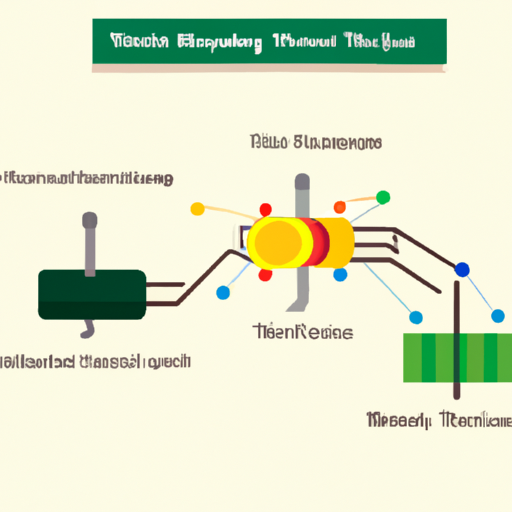What are the development trends in the resistor wiring diagram industry?
The Evolution of Renewable Energy: A Path Towards a Sustainable Future
I. Introduction
As the world grapples with the pressing challenges of climate change and environmental degradation, the importance of renewable energy has never been more pronounced. Renewable energy refers to energy derived from natural sources that are replenished at a faster rate than they are consumed. This includes solar, wind, hydro, biomass, and geothermal energy. The transition to renewable energy is crucial in combating climate change, reducing greenhouse gas emissions, and fostering sustainable development. This article will explore the historical context of energy sources, the various types of renewable energy, the role of technology, global trends and policies, economic implications, challenges, and the future of renewable energy.
II. Historical Context of Energy Sources
A. Traditional Energy Sources: Fossil Fuels and Their Impact
For centuries, fossil fuels—coal, oil, and natural gas—have been the backbone of global energy consumption. The Industrial Revolution marked a significant increase in fossil fuel usage, leading to unprecedented economic growth. However, this reliance on fossil fuels has come at a steep environmental cost. The burning of fossil fuels releases significant amounts of carbon dioxide (CO2) and other greenhouse gases into the atmosphere, contributing to global warming and climate change. The environmental consequences of fossil fuel extraction and consumption, including air and water pollution, habitat destruction, and health risks, have prompted a reevaluation of energy sources.
B. The Emergence of Renewable Energy
The quest for cleaner energy alternatives began in earnest in the late 20th century. Early uses of renewable energy can be traced back to ancient civilizations that harnessed wind and water for power. However, it was not until the 1970s energy crisis that significant investments were made in renewable technologies. Technological advancements in solar panels, wind turbines, and hydroelectric systems have paved the way for modern renewable energy solutions, making them more efficient and cost-effective.
III. Types of Renewable Energy
A. Solar Energy
Solar energy harnesses the power of the sun through photovoltaic (PV) cells that convert sunlight into electricity. Solar panels can be installed on rooftops or in large solar farms, providing a versatile energy solution. The benefits of solar energy include its abundance, low operating costs, and minimal environmental impact. However, challenges such as high initial installation costs and energy storage limitations remain.
B. Wind Energy
Wind energy is generated by converting the kinetic energy of wind into electricity using wind turbines. These turbines can be installed onshore or offshore, with offshore wind farms often yielding higher energy outputs due to stronger and more consistent winds. The advantages of wind energy include its low operational costs and minimal emissions. However, challenges such as noise, visual impact, and the need for suitable locations can hinder its expansion.
C. Hydropower
Hydropower is one of the oldest and most widely used forms of renewable energy. It generates electricity by harnessing the energy of flowing water, typically through dams. While hydropower is a reliable and efficient energy source, it raises environmental concerns, including habitat disruption and changes to local ecosystems. Sustainable practices, such as run-of-the-river systems, aim to mitigate these impacts.
D. Biomass and Biofuels
Biomass energy is derived from organic materials, such as plant and animal waste. It can be converted into biofuels, which can replace gasoline and diesel in transportation. Biomass plays a dual role in reducing waste and carbon emissions, as it utilizes materials that would otherwise contribute to landfill waste. However, the sustainability of biomass depends on responsible sourcing and land use practices.
E. Geothermal Energy
Geothermal energy harnesses heat from the Earth’s core to generate electricity or provide direct heating. Geothermal systems can be used for residential heating or large-scale power generation. While geothermal energy is reliable and has a small land footprint, its potential is limited to regions with suitable geological conditions.
IV. The Role of Technology in Renewable Energy
Technological innovations are driving the growth of renewable energy. Energy storage solutions, such as advanced batteries, are crucial for addressing the intermittent nature of solar and wind energy. Smart grid technology enhances energy distribution and management, allowing for more efficient use of renewable resources. Additionally, artificial intelligence and data analytics are being employed to optimize energy consumption, predict demand, and improve system reliability.
V. Global Trends and Policies in Renewable Energy
A. International Agreements and Commitments
Global efforts to combat climate change have led to international agreements, such as the Paris Agreement, which aims to limit global warming to well below 2 degrees Celsius. Countries are increasingly committing to ambitious renewable energy targets, recognizing the need for a transition to sustainable energy systems.
B. Government Incentives and Subsidies
Many governments are implementing incentives and subsidies to promote renewable energy adoption. These policies can include tax credits, grants, and feed-in tariffs that encourage investment in renewable technologies. Such support is essential for making renewable energy competitive with fossil fuels.
C. Case Studies of Countries Leading in Renewable Energy Adoption
Countries like Germany, Denmark, and China are at the forefront of renewable energy adoption. Germany’s Energiewende (energy transition) policy has led to significant investments in solar and wind energy, while Denmark has become a leader in offshore wind energy. China, the world’s largest producer of solar panels and wind turbines, is rapidly expanding its renewable energy capacity.
VI. Economic Implications of Renewable Energy
A. Job Creation in the Renewable Energy Sector
The renewable energy sector is a significant source of job creation. According to the International Renewable Energy Agency (IRENA), the sector employed over 11 million people globally in 2018, with numbers expected to grow as investments in renewable technologies increase.
B. Cost Comparison Between Renewable and Non-Renewable Energy Sources
The cost of renewable energy has plummeted in recent years, making it increasingly competitive with traditional fossil fuels. The levelized cost of electricity (LCOE) for solar and wind energy has reached parity with or is lower than that of coal and natural gas in many regions, driving further adoption.
C. Investment Trends and Future Market Predictions
Investment in renewable energy is expected to continue growing, driven by technological advancements, policy support, and increasing public awareness of climate change. According to BloombergNEF, global investment in renewable energy could reach $11 trillion by 2050, highlighting the sector's potential for economic growth.
VII. Challenges Facing Renewable Energy Adoption
A. Infrastructure Limitations
Despite the progress made, infrastructure limitations pose significant challenges to renewable energy adoption. Upgrading existing grids to accommodate distributed energy resources and improving transmission capabilities are essential for maximizing the potential of renewable energy.
B. Public Perception and Misinformation
Public perception and misinformation about renewable energy can hinder its adoption. Misconceptions about the reliability, cost, and environmental impact of renewable technologies must be addressed through education and outreach efforts.
C. Policy and Regulatory Hurdles
Inconsistent policies and regulatory frameworks can create barriers to renewable energy development. Streamlining permitting processes and establishing clear regulations are crucial for fostering a supportive environment for renewable energy projects.
VIII. The Future of Renewable Energy
A. Emerging Technologies and Their Potential Impact
The future of renewable energy is bright, with emerging technologies such as floating solar panels, advanced energy storage systems, and hydrogen fuel cells poised to revolutionize the sector. These innovations have the potential to enhance efficiency, reduce costs, and expand the reach of renewable energy.
B. The Role of Individuals and Communities in Promoting Renewable Energy
Individuals and communities play a vital role in promoting renewable energy. Grassroots movements, community solar projects, and local initiatives can drive demand for renewable energy and influence policy decisions at the local and national levels.
C. Vision for a Sustainable Energy Future
A sustainable energy future is achievable through a collective commitment to renewable energy. By investing in clean technologies, supporting policy initiatives, and fostering public awareness, we can create a resilient and sustainable energy system that benefits both people and the planet.
IX. Conclusion
The transition to renewable energy is not just an environmental imperative; it is an opportunity for economic growth, job creation, and sustainable development. As we face the challenges of climate change, the importance of renewable energy cannot be overstated. It is essential for individuals, businesses, and governments to take action, invest in clean technologies, and support policies that promote renewable energy adoption. Together, we can pave the way for a sustainable future powered by renewable energy.
X. References
1. International Renewable Energy Agency (IRENA). (2019). Renewable Energy and Jobs – Annual Review 2019.
2. BloombergNEF. (2020). New Energy Outlook 2020.
3. United Nations Framework Convention on Climate Change (UNFCCC). (2015). Paris Agreement.
4. U.S. Department of Energy. (2021). Solar Energy Technologies Office.
5. World Resources Institute. (2020). The Future of Renewable Energy: A Global Perspective.
This blog post provides a comprehensive overview of the evolution of renewable energy, highlighting its significance, types, technological advancements, global trends, economic implications, challenges, and future prospects. By understanding these aspects, we can better appreciate the critical role renewable energy plays in creating a sustainable future.







